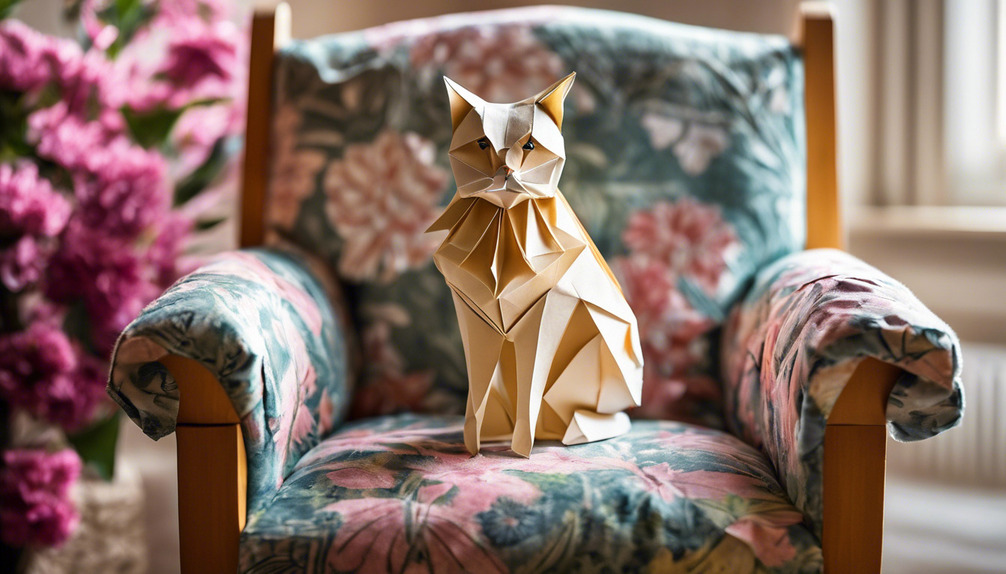It’s often joked that cats have nine lives, but when it comes to the health of your elderly cat, urinary tract infections (UTIs) are no laughing matter.
You might notice your beloved cat visiting their litter box more frequently, with each attempt to pass urine seemingly more strenuous than the last. They may even express their discomfort through painful cries or avoidance of the litter box altogether, opting for unusual places to relieve themselves.
As you watch for these subtle yet significant changes in behavior and bathroom habits, remember that these signs could point to a UTI—a condition that’s not only uncomfortable for your cat but can also lead to serious health complications if left unaddressed.
While you gently pat their head and ponder the changes you’ve observed, consider that understanding the full spectrum of symptoms is crucial to supporting the health and happiness of your aging cat.
Key Takeaways
- Frequent urination attempts, increased urgency and discomfort during urination, and straining to urinate are common signs of a urinary tract infection (UTI) in elderly cats.
- Changes in the color and clarity of urine, such as blood tinged urine with a pink or red hue, dark or cloudy urine, or strong odor urine, can indicate a UTI in elderly cats.
- Elderly cats may exhibit vocalization and behavior changes, such as sharp, pained meows, increased restlessness, and excessive grooming of the genital area, indicating pain and discomfort associated with a UTI.
- Increased time spent grooming, persistent licking of the same spot, wet fur around the genital area, and inappropriate elimination outside the litter box can also be signs of urinary discomfort and the need for veterinary attention in elderly cats.
Frequent Urination Attempts
If your elderly cat is frequently attempting to urinate, it may signal underlying urinary tract issues that warrant prompt veterinary attention. You’re likely observing more than just a quirky new habit; these frequent urination attempts could point to a discomfort they can’t express in words. Your compassion and vigilance are their voice, guiding you to understand that straining to urinate isn’t just inconvenient for them—it’s a plea for help.
Urinary tract disorders, such as Feline Lower Urinary Tract Disease (FLUTD), can manifest with increased urgency. Your cat might seek out unusual places to relieve themselves if they associate the litter box with pain. Watch for signs of distress: are they passing only a small amount of urine despite their persistent efforts? This could be a clear indicator of a urinary tract infection (UTI) or other serious conditions that affect their wellbeing.
Painful Urination Signs
You might notice your elderly cat visiting the litterbox more often than usual, a sign they’re experiencing discomfort. If they’re vocalizing when they try to urinate, it’s a clear signal that they’re in pain, and it’s important to listen for these distress calls.
Keep an eye on the color and clarity of their urine; any change could indicate a serious issue that requires prompt veterinary attention.
Frequent Litterbox Visits
When your elderly cat starts visiting the litterbox more frequently than usual, it may be a sign of painful urination, often indicating a urinary tract infection (UTI). It’s not just the number of visits that’s concerning, but also the discomfort your beloved pet might experience while passing urine. You might notice them straining, a telltale sign of urinary tract problems, or spotting only small amounts of urine. Blood may tinge their urine with an alarming pink or red hue, urging immediate attention.
If you observe these symptoms alongside excessive water consumption, it’s crucial to provide compassionate care by consulting your vet. Early detection and treatment can alleviate their distress and restore their well-being. Remember, you’re their trusted guardian against these silent ailments.
Vocalizing While Urinating
Beyond frequent litterbox visits, another distressing sign your elderly cat might display is vocalizing during urination, an unmistakable indicator of pain that warrants immediate veterinary care. When urinary tract infections afflict elderly cats, they may express their discomfort in the only way they can—through vocalizing.
Your pet suddenly starts crying out in pain, disrupting the usual quietness. They also make soft whimpering sounds, indicating discomfort. They growl or hiss when trying to relieve themselves, showing they are in distress. These sounds of distress naturally make you want to comfort them.
It’s essential to listen to these vocal cues. They’re a plea for help, a sign that it’s time to act with kindness and seek the gentle expertise of a veterinarian.
Altered Urine Appearance
A change in the color or clarity of urine is a noticeable symptom of a urinary tract infection in your older cat. When you notice urinary symptoms like urine tinged with blood, it’s a poignant reminder of your cat’s vulnerability. These changes in urine can indicate discomfort or pain during urination.
Here’s a table summarizing potential changes in urine appearance:
| Urinary Symptom | Possible Appearance | Implication |
|---|---|---|
| Frequent urination | Small, frequent deposits | Irritation or infection |
| Straining to urinate | Struggle with little output | Blockage or inflammation |
| Blood in urine | Urine tinged with blood | Infection or injury |
| Altered urine | Dark, cloudy or strong odor | Possible infection |
| Inappropriate urination | Outside the litterbox | Discomfort or distress |
Blood in Urine
One of the most alarming signs that your elderly cat may have a urinary tract infection is the presence of blood in their urine, a condition known as hematuria. This can be a distressing symptom for both you and your beloved pet, and it’s essential to understand what you might see:
- Pink-tinged urine: The once clear or yellowish urine may now appear with a rose-colored hue, indicating the presence of blood.
- Drops of blood: You might notice small, startling red droplets where your cat has just urinated.
- Discolored spots in the litter: Litter may clump together with unusual reddish or brown spots, a telltale sign of blood mixing with urine.
- Bloody trails: In severe cases, there may be traces of blood left where your cat rests or moves after using the litter box.
It’s crucial to recognize that blood in urine isn’t only a symptom of a UTI but could also indicate Feline Urinary Tract Disease, a spectrum of different urinary symptoms that could afflict your cat.
Promptly seeking veterinary care is imperative to address their discomfort and prevent more serious complications. Your tender care and vigilance can make a significant difference in their well-being.
Lethargy or Weakness
You’ve noticed your elderly cat isn’t quite themselves lately; they’re not jumping onto their favorite window ledge or greeting you with their usual fervor.
This decrease in activity could be a telltale sign of a urinary tract infection, where they may feel too tired or weak to engage in their normal routines.
If you’re seeing this unusual fatigue in your cat, it’s important to take them to the vet for a check-up to ensure their health and comfort.
Identifying Decreased Activity
When your once-energetic cat starts showing a noticeable dip in activity, it may be a sign that they’re struggling with the discomfort of a urinary tract infection. As a caring pet owner, you’re attuned to the subtle changes in your elderly cat’s behavior. Decreased activity can be concerning, and it’s critical to be vigilant about these signs:
- Your cat may spend more time sleeping, showing little interest in play or interaction.
- They might hesitate before jumping onto familiar perches or avoid them altogether.
- You could observe a general slowness in their movements, as if every step is laborious.
- An overall lack of energy, even during times of day when they used to be most active, can be apparent.
If you notice these changes, coupled with urinary symptoms, it’s important to consult your veterinarian to ensure your beloved pet receives the care they need.
Recognizing Unusual Fatigue
If your elderly cat exhibits increased lethargy or weakness, it’s crucial to take note as these could be telltale signs of a urinary tract infection called cystitis. As a caring pet guardian, you must watch for any decrease in activity levels or a reluctance to move. If your cat seems unusually tired or requires more rest than typical, these are common symptoms that shouldn’t be ignored.
It’s concerning when a cat that once prowled and played now spends prolonged periods in slumber. Your attentive eye can catch these subtle changes in energy levels. Should you recognize any of these signs of urinary tract issues, seeking veterinary attention is a compassionate step towards ensuring your beloved cat’s health and comfort.
Strong Urine Odor
Could your elderly cat’s strong urine odor be a sign of a urinary tract infection? It’s heart-wrenching to think that your cat could be in discomfort, when they’re unable to verbally express it. A strong urine odor is often a notable sign that something isn’t right with their urinary health.
Here’s what the strong urine odor might indicate:
- An ammonia odor that’s more pungent than usual could point to a concentration of waste products in your cat’s urine, often due to a UTI.
- The presence of a strong urine odor might be an early alarm for Feline Lower Urinary Tract Disease (FLUTD), a condition requiring prompt attention.
- A persistent, intense odor can suggest the formation of crystals, stones, or debris in the bladder or urethra, creating an environment ripe for bacterial growth.
- If the strong odor is coupled with other urinary symptoms, such as frequent trips to the litter box or discomfort while urinating, it’s time to consult your veterinarian.
Inappropriate Elimination
While a strong urine odor may be your first clue to a urinary issue in your elderly cat, another worrying sign to watch for is inappropriate elimination, such as finding urine in unexpected places around your home. It’s distressing to discover your beloved cat avoiding their indoor litter box, a place that’s been their comfort zone for years, and instead urinating around the house.
These actions aren’t out of spite; they’re a cry for help. Your cat may be experiencing a loss of bladder control or an inability to urinate properly due to a urinary tract infection (UTI). You might notice them straining to urinate in small amounts, or perhaps they’re visiting the litter box more frequently, yet nothing seems to alleviate their discomfort.
UTIs can instill a sense of avoidance or fear of the litter box, leading your cat to seek inappropriate areas outside of it. This is because they may associate the pain of urination with the litter box itself. As someone who desires to serve and support their cat, understanding this behavior is crucial. It’s a pivotal step in recognizing their need for medical attention and in providing the compassionate care they deserve.
Excessive Licking
You might notice your elderly cat spending more time than usual grooming themselves, particularly around their genital area. This obsessive behavior can signal discomfort or pain, prompting them to lick excessively in search of relief.
It’s crucial to distinguish between normal grooming habits and signs that may indicate a urinary tract infection.
Identifying Abnormal Grooming
When your elderly cat begins to lick their genital area excessively, it may be a sign they’re experiencing urinary discomfort or pain, often associated with conditions like FLUTD or a UTI. Paying close attention to your cat’s grooming habits can help you catch urinary symptoms early. Here’s what you might notice:
- Increased Focus: Your cat may zero in on their lower belly, obsessively grooming the area.
- Persistent Licking: They seem unable to stop, returning to lick the same spot repeatedly.
- Wet Fur: The fur around the genital area appears damp more often than not.
- Behavior Change: Your cat may avoid playful engagement, opting to groom instead.
These signs, along with excessive water consumption, suggest abnormal grooming behaviors that warrant a compassionate and prompt response to ensure your cat receives the care they need.
Licking: Pain or Relief?
We need to figure out if your older cat is grooming more because it’s in pain or uncomfortable, rather than just trying to stay clean.
Excessive licking in the genital area, could signify lower urinary tract issues, including a urinary tract infection called cystitis. It’s crucial to observe whether this compulsive licking is accompanied by other Symptoms of Feline Urinary concerns, such as straining to urinate or blood in the urine.
Your gentle observation can make a world of difference. If you notice such changes, it’s important to consult a veterinarian promptly. They can provide a proper diagnosis and relieve your beloved cat’s distress, ensuring their golden years are as comfortable and happy as possible.
Grooming Versus UTI Indicator
Is your elderly cat grooming or signaling a deeper health issue with their excessive licking? As a compassionate guardian, it’s crucial to discern the difference and understand when to seek help.
When your cat exhibits increased grooming, particularly of the genital area, this may not be a simple case of cleanliness. Instead, it could be one of the signs of urinary tract issues, such as a urinary tract infection called cystitis.
Consider these signs:
- Persistent licking at the genital area, more than usual grooming habits.
- Visible discomfort or irritation when grooming.
- Frequent trips to the litter box with little to no urine output.
- Sudden onset of this excessive grooming behavior.
These behaviors in elderly cats warrant a gentle and immediate conversation with your veterinarian.
Reduced Appetite
If your senior cat’s enthusiasm for meals has waned, it could be a red flag signaling a urinary tract infection (UTI), a condition that often goes unnoticed in elderly felines. As a tender caregiver, it’s important to recognize these subtle shifts in your cat’s behavior. A UTI, sometimes referred to as cystitis when the bladder is inflamed, can greatly affect your cat’s desire to eat.
Your once voracious cat might now turn their nose up at their favorite food, a change that warrants a gentle but immediate response. Alongside a reduced appetite, you might notice your cat exhibiting lethargy or even weight loss. This cluster of symptoms is a clear call to action.
It’s also vital to monitor their water intake. A decrease could exacerbate their condition if bladder stones or lower urinary tract disease are at play. These conditions can cause discomfort and distress, leading to an aversion to both food and water.
Your commitment to serving your cat means staying vigilant about these changes. Watch for shifts in eating habits and consult your veterinarian promptly. Early detection and treatment can make all the difference in your elderly cat’s health and well-being.
Behavioral Changes
When your elderly cat starts to exhibit unusual behaviors, it might be signaling a struggle with a urinary tract infection (UTI), which requires your gentle understanding and prompt attention. As a compassionate caregiver, recognizing these signs is crucial in providing the care your cat needs.
Here’s what to look out for:
- Altered Urination Habits: Your cat may visit the litter box more frequently, or avoid it altogether, which can be a clear symptom of urinary tract discomfort.
- Manifestations of Distress: You might notice increased vocalization or restlessness, as your cat tries to communicate its pain or unease.
- Excessive Grooming: Pay attention if they’re grooming their genital area more than usual, a sign they’re experiencing irritation or pain.
- Seeking Cool Surfaces: An unusual preference for cool places to lie down or urinate on may indicate your cat is trying to soothe the discomfort associated with FLUTD.
These behavioral changes in elderly cats point to symptoms of a urinary tract issue. They’re not just quirks, but silent cries for help that you, as a devoted caretaker, can answer with empathy and swift action. Remember, timely intervention can make a world of difference to your cat’s well-being.
Cloudy or Discolored Urine
Noticing your elderly cat’s urine taking on a cloudy or unusually tinted appearance can be a telltale sign of a urinary tract infection, necessitating a prompt visit to the vet. While it’s distressing to see your beloved cat in discomfort, understanding that discolored urine is a common symptom can help you take swift and compassionate action.
When urine shifts from its normal clarity to a milky or off-white color, it’s a visual clue that something’s amiss. This change can be indicative of a urinary tract infection called cystitis, where inflammation is present and may be causing your cat distress. Similarly, if the discoloration leans towards pink or red, it’s important to realize that this can signal the presence of blood, further underscoring the urgency for veterinary care.
Cloudy or murky urine often suggests that bacteria or inflammatory cells are present, further substantiating the presence of a UTI. As a caretaker devoted to your elderly cat’s well-being, you’ll want to pay close attention to these changes. Promptly seeking a veterinarian’s expertise not only addresses your cat’s immediate discomfort but also heads off any potential complications that could arise from an untreated infection.
Frequently Asked Questions
How Do Cats Act When They Have a Uti?
When your cat has a UTI, they’ll often strain to pee, produce little urine, may cry out in discomfort, and could even avoid their litter box, signaling you they need care.
How Long Can a Cat Have a UTI Before It Becomes Serious?
If a cat’s urinary tract infection (UTI) is not treated, it can worsen rapidly, often in just a few days. It’s important to address it quickly to reduce their discomfort and avoid the risk of severe, potentially fatal complications.
Are UTIs Common in Older Cats?
Yes, UTIs are quite common in older cats due to decreased kidney function and other age-related changes. It’s important to monitor their health and seek veterinary care if you notice any unusual symptoms.
What Happens if a Cat’s UTI Goes Untreated?
Just as you wouldn’t ignore your own health, if your cat’s UTI is left untreated, it could suffer from severe complications like kidney damage or life-threatening blockages. Care for them as you would yourself.




